Poker Hands
At our poker room, we deal with a variety of poker games, and each one uses a specific set of rules for ranking hands. Let's break it down:
The Classic Hand Rankings
Most poker games, like Texas Hold'em, Omaha, Seven Card Stud, and Five Card Draw, use the traditional high poker hand rankings. Here's the order from strongest to weakest:
1. Royal Flush: highest-ranking hand in poker. It consists of the Ace, King, Queen, Jack, and Ten of the same suit (e.g., all hearts, all diamonds, all clubs, or all spades).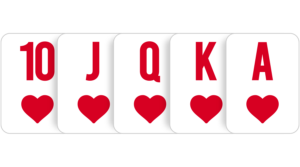 |
2. Straight Flush: Five cards in sequential order, all of the same suit. The highest straight flush wins, with the ultimate prize being the Royal Flush (Ace, King, Queen, Jack, Ten of a suit).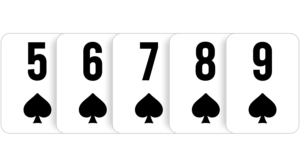 |
3. Four of a Kind: this hand consists of four cards of the same rank plus one additional card, called the kicker, which is used to break ties if two players have Four of a Kind. Also known as "quads."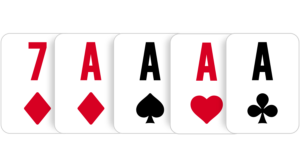 |
4. Full House: that consists of three cards of one rank and two cards of another rank. It’s sometimes referred to as a “full boat” or simply a “boat”.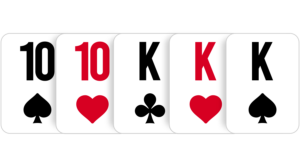 In the event of a tie, the Full House with the higher three-of-a-kind wins. If both players have the same three-of-a-kind, the pair (the two matching cards) is used to determine the winner. . In the event of a tie, the Full House with the higher three-of-a-kind wins. If both players have the same three-of-a-kind, the pair (the two matching cards) is used to determine the winner. . |
|
5. Flush: it is a hand where all five cards are of the same suit, but they are not in sequential order |
6. Straight: it is a hand that consists of five sequential cards of any suit. Unlike a Flush, the cards do not have to be of the same suit; they only need to be in consecutive order. |
|
7. Three of a Kind: it is a hand that consists of three cards of the same rank and two other unrelated cards. In the event of a tie, the player with the higher-ranked set of three cards wins. |
8. Two Pair: it is a hand that consists of two cards of one rank, two cards of another rank, and one unrelated card (the kicker). In the event of a tie, the player with the higher-ranked pair wins. |
|
9. One Pair: it is a hand that consists of two cards of the same rank and three other unrelated cards. In the event of a tie (if two players have the same pair), the winner is determined by the highest kicker among the three remaining cards. |
10. High Card: If no other hand combination is achieved, the highest card wins.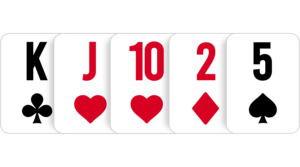 |
Ace To Five Lowball Hand Ranks
This method of ranking low hands is used in traditional Hi/Lo games, like Omaha Hi/Lo and Stud Hi/Lo, as well as in Razz, the ‘low only’ Stud game.
Note that suits are irrelevant for Ace to Five low. A flush or straight does not ‘break’ an Ace to Five low poker hand. Aces are always a ‘low’ card when considering a low hand.
Please also note that the value of a five-card low hand starts with the top card, and goes down from there.
Five Low, or Wheel: The Five, Four, Three, Deuce and Ace.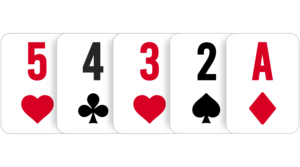 In the event of a tie: All Five-high hands split the pot. In the event of a tie: All Five-high hands split the pot. |
Six Low: Any five unpaired cards with the highest card being a Six.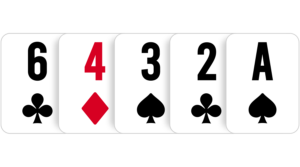 In the event of a tie: The lower second-highest ranking card wins the pot. Thus 6,4,3,2,A defeats 6,5,4,2,A. If necessary, the third-highest, fourth-highest and fifth-highest cards in the hand can be used to break the tie. In the event of a tie: The lower second-highest ranking card wins the pot. Thus 6,4,3,2,A defeats 6,5,4,2,A. If necessary, the third-highest, fourth-highest and fifth-highest cards in the hand can be used to break the tie. |
Seven Low: Any five unpaired cards with the highest card being a Seven.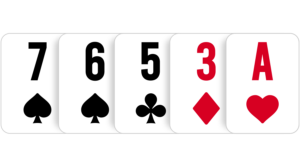 In the event of a tie: The lower second-highest ranking card wins the pot. If necessary, the third-highest, fourth-highest and fifth-highest cards in the hand can be used to break the tie. In the event of a tie: The lower second-highest ranking card wins the pot. If necessary, the third-highest, fourth-highest and fifth-highest cards in the hand can be used to break the tie. |
Eight Low: Any five unpaired cards with the highest card being an Eight.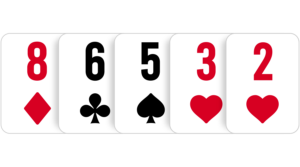
In the event of a tie: The lower second-highest ranking card wins the pot. If necessary, the third-highest, fourth-highest and fifth-highest cards in the hand can be used to break the tie. An Eight Low is the weakest hand that qualifies for low in Omaha Hi/Lo and Stud Hi/Lo. However in Razz, there is no such ‘qualifier’ and the lowest hand will always win the pot, even if it is a nine low, queen low, or even a pair! |
Deuce To Seven Lowball Hand Ranks
The Deuce to Seven Lowball hand rankings are the exact opposite of the traditional ‘high’ hand rankings. Therefore, the worst possible hand in traditional high poker – seven-five high, with different suits, becomes the best possible hand in deuce to seven lowball (a ‘perfect seven’ low or ‘wheel’).
In practice, an ace always plays as a high card in Deuce to Seven (so A,5,4,3,2 is an ace high, not a straight). Straights and flushes count against your hand in Deuce to Seven.
Seven Low: Any five unpaired, unconnected cards of different suits, with the highest card being a seven. The best possible hand is 7,5,4,3,2, also known as a ‘wheel’ or ‘number one’. 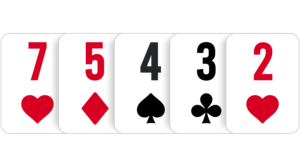
In the event of a tie: The lower second card wins the pot. Thus 7,5,4,3,2 beats 7,6,5,3,2 (a ‘Seven-Five low’ is better than a ‘Seven-Six low’). If necessary, the third-highest, fourth-highest and fifth-highest cards in the hand can be used to break the tie. |
Eight Low: Any five unpaired, unconnected cards of different suits, with the highest card being an eight.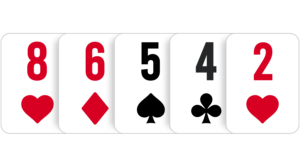 In the event of a tie: The lower second card wins the pot. If necessary, the third-highest, fourth-highest and fifth-highest cards in the hand can be used to break the tie. In the event of a tie: The lower second card wins the pot. If necessary, the third-highest, fourth-highest and fifth-highest cards in the hand can be used to break the tie. |
Nine Low: Any five unpaired, unconnected cards of different suits, with the highest card being a nine.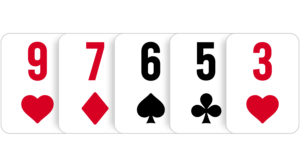 In the event of a tie: The lower second card wins the pot. If necessary, the third-highest, fourth-highest and fifth-highest cards in the hand can be used to break the tie. In the event of a tie: The lower second card wins the pot. If necessary, the third-highest, fourth-highest and fifth-highest cards in the hand can be used to break the tie. |
Ten Low: Any five unpaired, unconnected cards of different suits, with the highest card being a ten.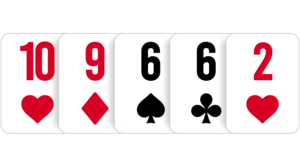 In the event of a tie: The lower second card wins the pot. If necessary, the third-highest, fourth-highest and fifth-highest cards in the hand can be used to break the tie. In the event of a tie: The lower second card wins the pot. If necessary, the third-highest, fourth-highest and fifth-highest cards in the hand can be used to break the tie. |
Note: There is no ‘qualifier’ for low in Deuce to Seven lowball games. The above are just examples of hands that may come up in play – the lowest hand will always win the pot in Deuce to Seven, even if it is a pair or worse!
How to understand who has the better hand in poker
When you’ve got the hand rankings down, you can then start thinking about the best way to play your hand and how likely it is to beat other hands.
In general, the following rules apply:
• One pair > high card
• Two pair > one pair
• Three of a kind > two pair
• Straight > three-of-a-kind
• Flush > straight
• Full house > flush
• Four of a kind > full house
• Straight flush > four of a kind
• Royal flush > straight flush
How can you calculate poker hand probabilities?
Poker card decks always have 52 cards and 2,598,960 possible hand combinations. To work out the probability of a hand, you need to consider the number of ways to achieve it.
For example, there are four different ways to get a royal flush because there are four suits. So, the math to work out the probability of this hand would be: 4 ÷ 2,598,960 = 0.00000154.
Contact us:


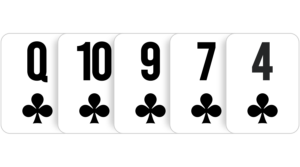 The rank of each individual card determines the strength of the Flush. In the event of a tie (when two players both have a Flush), the player with the highest card in their Flush wins. If the highest cards are the same, then the next highest card is compared, and so on.
The rank of each individual card determines the strength of the Flush. In the event of a tie (when two players both have a Flush), the player with the highest card in their Flush wins. If the highest cards are the same, then the next highest card is compared, and so on.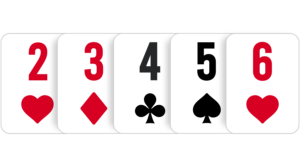 The highest card in the sequence determines the rank of the Straight. In the event of a tie (if two players have a Straight), the player with the higher-ranking Straight wins. The Ace can act as either the highest or the lowest card in a Straight, but it cannot be used as both.
The highest card in the sequence determines the rank of the Straight. In the event of a tie (if two players have a Straight), the player with the higher-ranking Straight wins. The Ace can act as either the highest or the lowest card in a Straight, but it cannot be used as both. If both players have the same Three of a Kind, then the highest kicker (one of the other two cards) determines the winner.
If both players have the same Three of a Kind, then the highest kicker (one of the other two cards) determines the winner.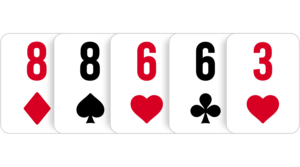 If both players have the same highest pair, then the second pair is compared. If both pairs are identical, the kicker decides the winner.
If both players have the same highest pair, then the second pair is compared. If both pairs are identical, the kicker decides the winner.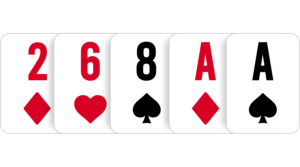 If the highest kicker is the same, the next highest kicker is compared, and so on.
If the highest kicker is the same, the next highest kicker is compared, and so on.
